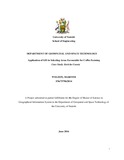| dc.description.abstract | Use of geospatial technology in agricultural production has brought a lot of revolution towards better achievements. Before this technique was directed towards agricultural fields, farmers at all levels leveraged on certain unpredictable gambling while trying to decide on suitable areas for their crops. Losses have been witnessed because of failure to do prior analysis before any farming activity is started. This has led to misuse of labour and farm inputs, not to mention waste of time, which could have been avoided through certain approaches.
Use of GIS (Geographic Information Systems) technology, together with other Multi-Criteria Evaluation (MCE) methods in carrying out suitability analysis has created an avenue of doing land planning. This has made it possible to assigned development activities to appropriate sites. Areas favourable for coffee growing in Kericho County have been identified using these technologies. The type of coffee being studied is the Arabica coffee. Kericho County is at an altitude which cannot favour the growing of Robusta coffee. It is because of this reason that the study was confined to Arabica Coffee. Therefore, whenever coffee is mentioned in any part of this research then it refers to the Arabica coffee. By use of such factors as climate, topography and soil as the main criteria in the study, sub-criteria were extracted from them.
Climate, rainfall and temperature were considered as separate entities which affect the process of determining areas favouring coffee growing in the County. Topography, on the other hand, carries two distinct elements, elevation and slope. Soil entails soil texture, which is related to soil type, soil pH, soil depth and soil drainage. Cation Exchange Capacity (CEC) was not considered since it is mainly dictated by the aforementioned attributes of soil. Present land use and land cover analysis was also done through the use of Landsat 8 satellite image for the area acquired in 2016. The image is within path 169 and row 60. Image enhancement, supervised image classification using Maximum Likelihood Classifier (MLC) and validation of classified results was done. Once the factors were put in a model on ArcGIS 10.2 software, their weighted overlay was further overlaid with unwanted land use classes to obtain potential areas for coffee farming. Economic analysis was done using the potential areas and areas with existing coffee farms so as to appreciate the expected per capita income from the crop. | en_US |

